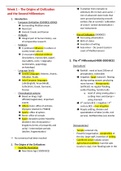Week 1 – The Origins of Civilization Transition from nomadic to
sedentary life (in huts and caves) /
and the Second Millennium Use of advanced stone tools that
1. Introduction were ground (producing smooth
- European Civilization (3500BCE-500AD) surface, flat or curved) / cultivation
Surrounding Mediterranean of cereal / animal domestication /
Near East war instruments
Ancient Greeks and Roman
- Antiquity - Rise of Civilization (3000BCE)
Integral part of human history, use Increasing urbanization
of comparative research Birth of states
- Evidence Invention of writing
1) profound influence in culture or Asia minor – De Levant (eastern
society (Arab culture) coast of Mediterranean)
2) excavated physical evidence
(inscriptions, manuscripts, papyri,
clay tablets, coins = epigraphy, 3. The 4th Millennium(4000-3000 BCE)
numismatics, papyrology,
[Agriculture]
archaeology)
- Language family Rainfall : need at least 250mm of
Semitic languages: Hebrew, Aramic, precipitation, vulnerable
Akkadian, Arabic Irrigation: Egypt (natural) : flowing
Indo-European languages: during sowing seasons producing
Latin(English), Aryan(Hindi), more harvest / Mesopotamia
Celtic(Irish), Greek, Germanic, (artificial): no regular flooding,
Persian earlier flooding, harmful salts
- Chronological systems o need of using sowing plow +
Based on kings, high curbing rivers and damps +
officials(magistrates), important using channels
events 6 century BCE = irrigation / 4th
th
Athens (July), office of archons, century BCE = river irrigation
Olympics (started in 776BCE) People settling, division and
Sparta: office of ephors specialization of labor (crafts, civil
Rome: office of consuls service), fortified cities (ex) Jericho
Egypt: dynasties (priest Manetho
divided it into 30 dynasties) /
kingdoms (terms of prosperity and [Mesopotamia]
unity) / intermediate periods
- Temple centered city
(decline, fragmentation)
- Powerful organization, complexities of
the city, large staff, invention of writing
No consensus had been reached
- Cuneiform script (syllabic script)
- Agricultural conditions: harmful salts
2. The Origins of the Civilizations
(cracks in clay), river flooding later in the
- Neolithic Revolution
New Stone Age (10000 BCE)
, year, conducting water through canals, Reports of famine (started artificial
more barley irrigation)
- Geographical conditions: transition
between deserts and arable land more
gradual 4-3. Mesopotamia – Summer & Akkad (3000-2100)
o Constant invasions from the outside
- Sumerians (3000-2300)
world, considerable degree of
Sumerian civilization: making
continuity
independent city states and city
Gods, Sumerian language (= scholar
[Egypt] language), cuneiform script
Sumerian City States (2600-2400):
- Hieroglyphic script
Kis, Uruk, Umma, Lagas, Ur, Nippur
- Agricultural conditions: flooding during
The Gilgamesh of Uruk (2700) / The
the sowing season, fertile water, more
Vase of Uruk (leader of society in
wheat
religious sense)
- Geographical conditions: isolated,
surrounded by desert
- Akkadians (2300-2100)
o Political unification, stable and static
Unified the Sumerian city States
Semites (Semetic people)
Used own language (Old Akkadian)
4. The Third Millennium own worship of deities, claimed
(The Early Bronze Age; 3000-2000 hegemony (“King of the Four
BCE) Quarters of the World)
King Sargon(2350) = the first to be
powerful over the Mesopotamia (all
4-1. Egypt – The Early Dynastic Period (3000-2600)
the way to N. Mesopotamia, Asia
- Hieroglyphic script invented (writings minor)
introduced)
- “The Lord of the Two Lands” = upper
Egypt (South of Delta, First Cataract) / - Kingship
lower Egypt (Nile Delta) considered as descendants from
o Ex) Narmer(Menes) Palette, The heaven (weak power)
Double Crown (Dewen, Ptolemy 6) Power surrounding temple, ruler
priest + military leader (sometimes
even the same person), later the
4-2. Egypt – The Old Kingdom (2600-2150) rulers changed into dichotomy
(secular palace ruler <-> priest
- Construction of pyramids temple ruler)
Tremendous power of kingship Several kings over the whole
Built near Memphis Mesopotamia (unlike Egypt, who
Largest built during the 4th dynasty was politically united)
Pyramids near Giza
- End of the period 4-4. Mesopotamia – Third Dynasty of UR
Weakened central authority - 2200 Collapse of Akkadian empire
- 2100 Third Dynasty of UR
, Sumerian Renaissance - Ruled by the Hyksos (until 18 BCE)
Palace acquiring complete control From Levant and south of
- 2000 invaded by the Amorites Mesopotamia
People using W. Sematic languages Settled near Nile Delta
Invaded Babylonia Built own dynasties, capital of Avaris
Local officials making independent
5-3. Mesopotamia – Old Assyria & Old Babylonia
dynasties
Climate change - Old Assyrian Empire (2000-1760)
Northern Mesopotamia
City of Assur
4-5. End of the Third Millennium o Gained independence from Akkad
empire & UR
- Great confusion and stagnation (climate
Profitable trade (wealth and
change)
prominence), Kanesh (trading post)
- Distinctive culture and technology in
Ex) imported tin from Asia minor,
Europe
intensive mining
- Language
Ex) 2000 clay tablets of commercial
Akkadian used as a spoken,
contacts
international language (literary
Become vassal of Mitanni
texts)
Sumerian used as a scholarly
- Old Babylonian Empire (1800-1600)
language
Southern Mesopotamia
- Strong influence of Sumero-Akkadian
City of Babylon
culture
o Strong political power
o Influence on Mesopotamian culture
(gods, traditions)
5. The Second Millennium (The Middle
Hammurabi (1770, Amorite King) :
Bronze Age; 2000-1000 BCE) king chosen by God, made code of
5-1. Egypt – The Middle Kingdom (2000-1800 BCE; law based on the divinity
11-12th dynasties) Decline by foreign invaders
o Hittite kingdom
- ruled by Thebes (1900-1800) o Kassite domination (1600-
pharaoh: Amenemhat 3, Sesostris 3
1300)
Dynasty of provincial governors,
new unified realm, military
campaigns
- The Amorties
Extended way to Nudia (3rd Cataract)
Settled near Assur, Babylon, Mari
City of Fayyum becomes oasis of
Hybrid position, nomadic way of life
cultivation (Amenemhat 3)
(constant invasions on Assyria) (set
- Rise of Egyptian culture
kings in Babylonia)
Literature, hieroglyphs
5-2. Egypt – Second Intermediate Period (1800-
1560; 15-16 dynasties)
- Power of kings decline, unity weakened





